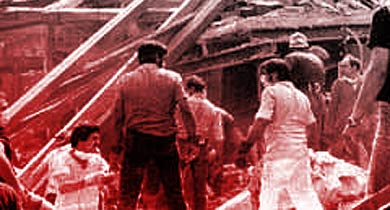The bombs have just exploded in Madrid on March 11,
2004, when the Spanish Interior Minister, even before the beginning of
the investigation, already named those responsible for the attacks: the
Basque pro-independence organization ETA. A few hours later, other
authorized voices also accused Al Qaida. All television networks
interrupted their usual programming to cover the attack, drawing
conclusions based on these two hypotheses. So, all of them played the
game of disinformation thus favoring the true ringleaders whom we still
don’t know. Why? Because, losing their sangfroid and their cool and
letting their emotions take control, these media outlets and government
officials repeated thousands of accusations that will not help in
clarifying what happened in Madrid but they teach us about the
prejudices of those who made them.
Historical Precedents
The role of a journalist should be, mainly, to analyze the events using his own internal logic, to study the terrorists’ modus operandi and their targets, to see what is at stake and who benefits from the crime and what it may represent. For that, the journalist uses comparative studies of historical precedents. Thus, blaming a Basque group for an operation of this magnitude, only because it took place in Spain, is thoughtless and unreliable.However, that is what the highest officials of the ruling party of Spanish President Aznar said. We have to recall, before anything else, that the deadliest attacks in Europe in the last sixty years, like the one in Moscow (250 dead in September 1999) and the one in a train station in Bologna, Italy (85 dead in 1980), were wrongly and quickly attributed to opposition members or fanatics although those attacks matched a predetermined logic: “the tension strategy”.
Thus far, nothing indicates that this theory applies for the Madrid attacks. It is not about chasing this hypothesis instead of others. No trail should be disregarded, that is the most important thing. But recalling the attacks that took place in Italy may help us understand a little bit the recent events in Madrid.
Like in the attacks in Madrid, the target of the bomb that exploded on August 2nd, 1980, in the train station of Bologna (Italy) was the railroad. On that occasion the attack left 85 people dead and 150 wounded. The bomb was planted in the waiting room of the second-class passengers. It was August and it was an important intersection point of the national railroad traffic. The objective was to kill as many passengers as possible. The target was the common people: Bologna was a bastion of the Italian Communist party. In Madrid, the trains attacked were mainly used by a sector of the working class of the suburbs who come from the working-class neighbourhoods. They were the target of the terrorist attacks.
In their investigation about the attack in Bologna, the Italian judges, with a vast experience in the matter as a consequence of dealing for year with violence and terrorism orchestrated in complicity with the Italian state, quickly went after the trail of the extreme right. However, the Italian secret services of General Santovito [1] did everything possible to move the judges away from the good trails giving them false and wrong information. According to the magistrates, whose version is registered in the files of the Court of Justice of November 23rd, 1995, «the SISMI sent us a lot of information that was hardly verifiable in order to lead us into exhausting and unproductive tracks and/or investigations».
The Bologna tragedy was the peak of a long list of deadly attacks that took place in Italy since the early 1970s. One of the first attacks took place on December 12, 1969. On that day, in Milan, at 16:37, a bomb destroyed the hall of the Bank of Agriculture killing 16 people and wounding 88. A few minutes earlier, an employee in the Italian Commercial Bank found a black briefcase with a bomb inside whose detonating system did not work. Twenty minutes later, in Rome, a second explosion took place in the National Labor Bank wounding 16 people. At 17:22 and 17:30, two other bombs exploded: one, in front of the Monument of the Dead in Rome, and the other at the entrance of the Risorgimento Museum in Piazza Venezia. Fortunately, this second wave of attacks left only four people wounded.
READ MORE....

Geen opmerkingen:
Een reactie posten